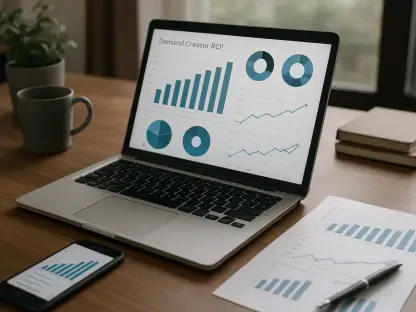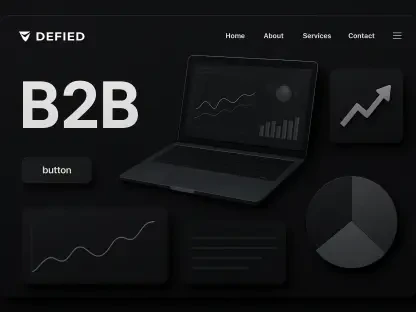Introduction to YouTube Ads for B2B Success
Picture a scenario where a B2B marketer struggles to break through the noise of traditional advertising channels, grappling with high costs per lead and lackluster brand awareness for complex solutions. In a landscape where decision-makers are inundated with information, capturing attention requires a fresh approach. YouTube, often seen as a platform for consumer-focused campaigns, emerges as an unexpected yet powerful tool for B2B marketing, challenging preconceived notions about its relevance in this space.
The B2B arena, characterized by intricate products and extended sales cycles, demands innovative strategies that go beyond direct conversions. Video advertising on YouTube offers a unique opportunity to build trust and educate potential clients at scale. This guide delves into how this platform can transform lead generation efforts by enhancing visibility and supporting other marketing channels.
Key areas of focus include the distinctive role of YouTube in B2B strategies, real-world examples demonstrating its impact, actionable tactics for effective campaigns, and final recommendations for seamless integration. By exploring these elements, marketers can uncover a pathway to amplify their outreach and drive meaningful results in a competitive environment.
Why YouTube Ads Matter for B2B Marketing
Contrary to popular belief, YouTube Ads hold significant value for B2B marketing, even if their impact is not always immediate. While direct conversions may be rare due to the complexity of B2B offerings, these ads excel at fostering brand awareness and influencing downstream lead generation. They create a foundation of familiarity that primes prospects for engagement through other channels.
Incorporating YouTube into a broader B2B marketing strategy yields multiple benefits, such as boosting search performance, lowering cost per lead, and strengthening brand consideration among target audiences. The visual storytelling aspect of video content allows businesses to convey intricate value propositions in a digestible format, making a lasting impression on decision-makers. This indirect influence often translates into measurable gains when paired with paid search or other tactics.
Skepticism about YouTube’s effectiveness for B2B is common, yet its supportive role cannot be overlooked. By complementing channels like paid search, it enhances overall campaign efficiency, ensuring that prospects are more informed and receptive when they encounter subsequent touchpoints. This synergy underscores the platform’s strategic importance in a well-rounded marketing mix.
Proven Strategies for B2B YouTube Ad Campaigns
Crafting successful YouTube Ad campaigns for B2B requires a tailored approach that aligns with specific business goals. Unlike consumer-focused efforts, B2B campaigns must prioritize education, precision, and integration with other marketing efforts. The following best practices provide a roadmap for maximizing impact through targeted and compelling video content.
Effective campaigns hinge on meticulous planning across targeting, content creation, bidding, and budget management. By focusing on high-intent audiences, delivering concise messaging, and optimizing spend, marketers can achieve significant returns without exorbitant costs. These strategies ensure that every dollar invested contributes to long-term growth and brand equity.
The real-world impact of these tactics is evident in diverse B2B contexts, from local businesses to global enterprises. Detailed guidance on each element, supported by practical examples, offers a clear path forward for marketers aiming to leverage YouTube’s unique capabilities in driving meaningful engagement and supporting lead generation.
Leverage Custom Segments for Precision Targeting
Precision targeting forms the backbone of any effective B2B YouTube campaign, ensuring that content reaches the most relevant audiences. Custom segments based on high-performing search keywords allow marketers to zero in on prospects with demonstrated intent, avoiding the inefficiencies of overly broad or in-market audience settings unless substantial budgets are allocated for awareness initiatives.
Beyond keywords, utilizing first-party data to create lookalike audiences in Demand Gen campaigns can further refine outreach efforts. Equally critical is geo-targeting, which prevents wasted spend by focusing on specific regions aligned with business objectives. This disciplined approach maximizes relevance and minimizes unnecessary exposure in irrelevant markets.
Case Example: Geo-Targeting Success
A local B2B business saw remarkable efficiency gains by narrowing its YouTube campaign to select city areas where its services were most needed, ensuring that every impression counted. Similarly, an enterprise SaaS client targeting global markets achieved better results by carefully choosing specific countries, avoiding regions with low potential. These examples highlight how precise geographic focus sharpens campaign performance and optimizes resource allocation.
Create Short, Branded Videos for Maximum Engagement
The power of brevity cannot be overstated when designing YouTube Ads for B2B audiences with limited attention spans. Videos lasting 15 to 30 seconds, with prominent branding such as logos or company names in the opening moments, capture interest swiftly and establish identity before viewers disengage. This immediate recognition is crucial for building trust in a short window.
To sustain engagement over time, producing multiple video variations helps combat viewer fatigue. Slight differences in messaging or visuals keep content fresh, encouraging repeated interactions without diminishing impact. This strategy ensures that campaigns remain dynamic and relevant throughout their run, catering to diverse audience preferences.
Case Example: Video Impact on Brand Awareness
An enterprise SaaS client effectively used concise videos to distill complex solutions into digestible snippets, leading to notable improvements in click-through rates and conversion rates in complementary search campaigns. By addressing specific pain points within seconds, the content resonated with viewers, enhancing their understanding and readiness to act. This case underscores the value of brevity and clarity in driving measurable outcomes.
Optimize with Cost-Effective Bidding and Budgeting
Budget constraints need not hinder the success of B2B YouTube campaigns when smart bidding strategies are employed. Opting for a Target Cost Per View (CPV) approach allows marketers to maximize reach while maintaining control over expenses, often achieving CPVs below $0.01. This cost-effective method ensures broad visibility without straining financial resources.
Remarkably, impactful results can emerge from modest investments, with successful campaigns often allocating less than 5% of total marketing budgets to YouTube. This efficiency demonstrates that strategic planning and execution outweigh the need for hefty funding, making the platform accessible to businesses of varying scales.
Case Example: Budget Efficiency in Action
A local B2B business experienced a 47% surge in brand search cost per lead when its small YouTube budget was paused, revealing the channel’s subtle yet vital role. Upon reinstating the campaign with Demand Gen integration, costs returned to normal and even decreased further. This scenario illustrates how minimal spend on YouTube can yield outsized benefits when thoughtfully managed.
Conclusion: Maximizing B2B Growth with YouTube Ads
Reflecting on the journey, YouTube Ads have proven to be a game-changer for B2B marketing, with case studies showcasing enhanced search performance and reduced costs per lead. These outcomes validate the platform’s capacity to transform how businesses approach brand consideration and lead nurturing, even in challenging environments.
Moving forward, B2B marketers are encouraged to experiment with YouTube as a complementary channel, particularly for complex offerings or localized services. Starting with small, targeted campaigns and closely monitoring indirect impacts offers a low-risk entry point to uncover potential synergies with existing strategies.
The next step involves refining video content to match audience needs while integrating insights from performance data to fine-tune future efforts. By embracing continuous optimization and exploring cross-channel opportunities, businesses can position themselves to unlock sustained growth and competitive advantage in their markets.









